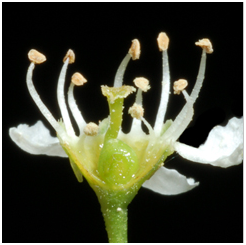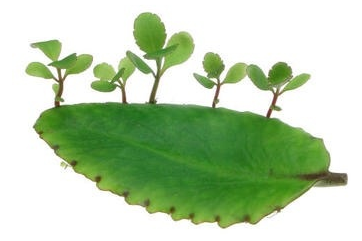The inflorescence shown in the given figure is:

1. Hypanthodium where A are male flowers and B are female flowers
2. Hypanthodium where A are female flowers and B are male flowers
3. Verticillaster where A are male flowers and B are female flowers
4. Verticillaster where A are female flowers and B are male flowers

2. Hypanthodium where A are female flowers and B are male flowers
3. Verticillaster where A are male flowers and B are female flowers
4. Verticillaster where A are female flowers and B are male flowers
Look at the dorsifixed condition of stamens in the given picture. This can also be seen in flowers of:

1. Mustard
2. Michelia
3. Passion flower
4. Salvia
Match each item in COLUMN I with one in COLUMN II and select the correct answer from the codes given:
|
|
COLUMN I [Racemose inflorescence] |
|
COLUMN II [Example] |
|
A. |
Spadix |
a. |
Wild coriander |
|
B. |
Corymb |
b. |
Sunflower |
|
C. |
Umbel |
c. |
Aroids |
|
D. |
Head/capitulum |
d. |
Candytuft |
Codes
A B C D
1. a b c d
2. b a d c
3. c d a b
4. d c b a
The internode eleongation of the thalamus seen in the picture is called as:

1. Anthophore
2. Androphore
3. Gynophore
4. Gynandrophore
What is the position of the ovary and the term for flower in the given figure?

1. Inferior, Epigynous
2. Superior, Hypogynous
3. Inferior, Hypogynous
4. Half-inferior, Perigynous
What type of aestivation is seen in the corolla of the flower shown?

1. Valvate
2. Imbricate
3. Vexillary
4. Twisted
The position of ovary and the type of flower shown in the given picture will respectively be called as:

1. Superior, Hypogynous
2. Superior, Epigynous
3. Inferior, Hypogynous
4. Inferior, Epigynous
The following can be the leaves of:

1. Larkspur
2. Limnophila
3. Pistia
4. Bryophyllum
The position of the ovary in the flower shown is:

1. Superior
2. Half superior
3. Inferior
4. Half inferior
Match each item in COLUMN I with one in COLUMN II and select the correct answer from the codes given:
|
|
COLUMN I [Fruit name] |
|
COLUMN II [Edible part] |
|
A. |
Apple |
a. |
Juicy placental hair |
|
B. |
Guava |
b. |
Thalamus and pericarp |
|
C. |
Orange |
c. |
Fleshy thalamus |
|
D. |
Litchi |
d. |
Aril |
Codes
A B C D
1. b c d a
2. b d a c
3. c b a d
4. d c b a



